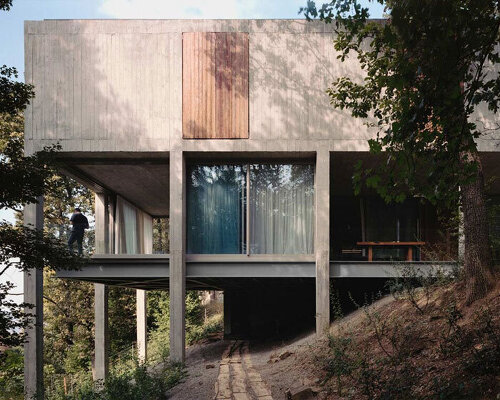Wunderwerk builds Detached House on Tskneti’s forested slopes
Set on the forested slopes of Tskneti, Georgia, Detached House by Wunderwerk is situated in a landscape historically shaped by enclosure, both physical and social. Positioned above a natural ravine, the house approaches the site through an architectural strategy that prioritises openness. A suspended concrete volume, transparent ground-floor living spaces, and a landscape that flows freely through the site form a residence in which the surrounding forest remains integral to the spatial experience.
For centuries, the mountainous perimeter of Tbilisi has acted as a climatic buffer and recreational zone. Within this area, Tskneti occupies the eastern slope of the Trialeti Range, where the urban grid transitions into oak and pine forests. During the Soviet era, the district became a suburban resort defined by state-built sanatoria and managed woodland. Later, private dachas created a closed social environment associated with political and cultural elites, while broader access to these spaces remained limited. Following the 1990s, the area experienced significant shifts. Vacated villas were occupied by internally displaced families, and new private properties were consolidated behind tall concrete walls. Enclosure became a dominant spatial condition, with boundaries functioning less as architectural elements and more as territorial markers that altered the landscape and reduced shared outdoor space. This practice ultimately shaped local construction habits, producing an entrenched expectation of solid, opaque fencing. Recent municipal regulations have begun to restrict this trend, aiming to reintroduce visual and spatial permeability across the district.
all images by Angus Leadley Brown
Tskneti house is elevated above steep terrain to minimise impact
The house responds to this context by proposing an alternative approach to boundaries. Located at the southeastern edge of the settlement, the plot borders a ravine that contributes to the natural ventilation system of both Tskneti and Tbilisi. Its steep terrain had previously discouraged development. The design process focused on minimising impact on the site while maintaining the ecological role of the landscape. The structure is elevated above the slope in an existing clearing, supported by tall concrete columns anchored into the bedrock. These columns carry a monolithic concrete volume containing the private areas on the upper level.
Below, a suspended metal frame forms the ground-floor platform, accommodating an open living area enclosed by a continuous glazed facade. This transparency establishes direct visual connections with the forest. Studio Wunderwerk collaborates with landscape design Studio Ruderal to extend native vegetation into the plot, maintaining ecological continuity and eliminating the need for perimeter walls. A large terrace provides a transitional space, and a sliding corner facade enables a flexible boundary between interior and exterior. On the upper level, windows are positioned to frame specific views into the forest. Externally, folding wooden shutters and timber-form concrete create a material palette intended to weather gradually into the surrounding environment. Interior elements continue this logic with shutter-like wooden components that conceal functional features. The house reinterprets the traditional boundary wall of Tskneti as a suspended architectural volume combined with an open ground plane. Through this configuration, the project introduces a spatial model that prioritises environmental continuity, ventilation, and visual openness within a suburban context historically defined by enclosure.
the house is set on the forested slopes of Tskneti
the building is positioned above a natural ravine
suspended concrete volume defines the upper level
transparent ground-floor spaces are connected to the forest
landscape extends freely through the plot
the structure is elevated above steep terrain to minimise impact
continuous openings frame direct forest views
the house is designed as an alternative approach to enclosure
sliding corner facade enabling fluid interior–exterior transition
timber and textured concrete blend with the natural surroundings
architectural concept redefines the boundary wall as open and permeable
Detached House In Tskneti is located where the city meets oak and pine forests
project info:
name: Detached House In Tskneti
architect: Wunderwerk | @wunderwerk.architecture
design team: Gigi Shukakidze, Nikoloz Lomidze, Barbare Kacharava, Irina Dikhaminjia
structure: Q Engineering
MEP/HVAC: Casa Calda
landscape design: Ruderal
area: 300 sqm
location: Tskneti, Georgia
photographer: Angus Leadley Brown | @angusleadleybrown
designboom has received this project from our DIY submissions feature, where we welcome our readers to submit their own work for publication. see more project submissions from our readers here.
edited by: christina vergopoulou | designboom
The post concrete columns lift residence above forested terrain in georgia appeared first on designboom | architecture & design magazine.

